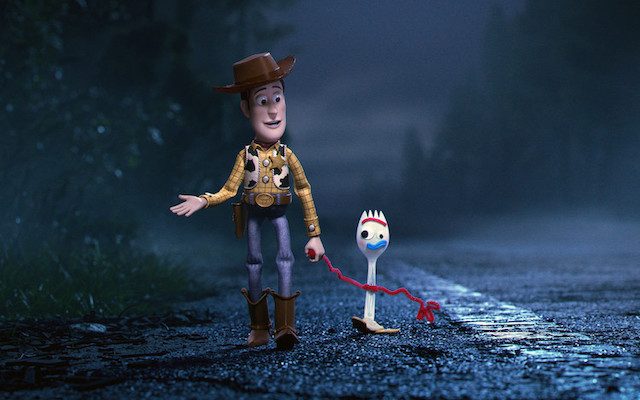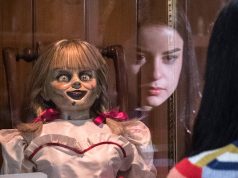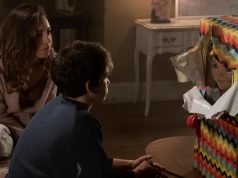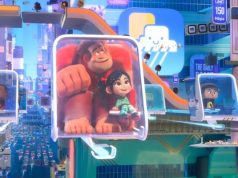
“Toy Story 3” was such a perfect culmination to the series that any “Toy Story 4” is going to be met with wariness. The “Toy Story 4” we got does nothing to allay those concerns — it is, as expected, an unnecessary addition, though I do like where the characters all end up — and it’s my least favorite of the four. But least favorite compared to three grade-A movies is still pretty good, and there are moments of the usual brilliance sprinkled throughout this serviceable, affectionate epilogue.
Before it can begin, however, “Toy Story 4” must explain why Bo Peep (voiced by Annie Potts) wasn’t in “Toy Story 3.” We learn that prior to the events of that film, Ms. Peep was put in a box to be given away and declined Woody’s (Tom Hanks) efforts to rescue her because she was OK with moving on. Unlike Woody, who was devoted to his kid, Andy, and has not gotten over Andy’s growing up and moving away, Bo Peep is at peace with the toy’s lot to be played with and then passed along.
In the present, a year or so after “Toy Story 3,” Woody, all of the old toys, and the new ones we met in “3” are the happy property of young Bonnie (Madeleine McGraw), who’s about to start kindergarten. Bonnie has little use for Woody, having made Jessie (Joan Cuscak) sheriff of her pretend town, and the gentle old cowboy feels worthless. He gets a new mission in life when Bonnie makes a toy at kindergarten, brings it home, and loses it. A rescue mission! That’s what Woody is best at, if the events of every film in this series are any indication!
Now, about Bonnie’s new toy. He’s made out of a plastic spork, a pipe cleaner, and other debris. Bonnie named him Forky, and for reasons nobody can understand, he came to life (voiced by Tony Hale) the way all toys do. Being made of trash, Forky believes himself to be trash, and he keeps throwing himself away while Woody keeps frantically rescuing him in a montage set to one of Randy Newman’s most on-the-nose songs yet, entitled “I Can’t Let You Throw Yourself Away.”
Forky is a wonderfully weird addition to the cast, an agent of pure chaos, horrified to be alive at all, insistent that he is NOT supposed to be a plaything. Unlike every other toy in these movies (even the villainous ones), Forky is either unaware of or unconcerned about the rule that says toys don’t move or speak when people are around, giving Woody one more thing to worry about.
But the story still has more places to go. Forky gets lost in a quaint old Western town called Grand Basin (reminds me of Telluride, Colo.) while Bonnie and her parents are on an RV road trip. Woody’s search for Forky leads to an antique shop in the town where a homecoming queen of a talking doll (Christina Hendricks), guarded by a silent squad of creepy ventriloquists’ dummies, says Bo Peep once lived. This doll, Gabby Gabby, can talk the way most toys in this universe can talk, but her voice box — the thing that makes her a “talking doll” for little girls to play with — is broken, hence her consignment to a dusty shelf in an antique store. She wants Woody to donate his to her, whether Woody wants to or not.
And there’s more! A traveling carnival is currently in Grand Basin, and this is where we find Bo Peep living the life of a “lost toy,” unencumbered by belonging to anyone. More so than in previous chapters, this installment talks about the relationship between toy and kid like a marriage. Woody hasn’t gotten over the end of his last one; Bo Peep has decided she doesn’t need one; other toys, like the plush Ducky and Bunny (Keegan-Michael Key and Jordan Peele) waiting to be won in a carnival game, yearn for the day when they will have one. An old action figure, Duke Caboom (Keanu Reeves) — “Canada’s greatest stuntman” — never recovered from being rejected by his kid on Christmas morning when the kid discovered Duke wasn’t as capable as he seemed in the TV commercial. The aisle of used toys is littered with broken hearts.
These movies have all been about toys’ existential crises. Now, with Forky, we finally have one asking a fundamental question that the others evidently never considered: Why am I alive? What a deep, somber, potentially bleak subject! In a G-rated kids’ cartoon! I love it. While that’s going on, Buzz Lightyear (Tim Allen) has misunderstood Woody’s talk of an “inner voice” (i.e., one’s conscience) and thinks it means the prerecorded messages that play when you push a toy’s buttons or pull its string. So he’s going around making decisions by pressing his own buttons and doing what they say … and the random “advice” proves useful in every instance. Is this a cosmic joke? Are we all kidding ourselves thinking we obey a higher power or a conscience when really we’re just following random, self-generated instructions? How marvelous that a Disney cartoon is making us think about these things.
The problem is simply one of comparison: “Toy Story 4” isn’t nearly as funny or emotionally powerful as its predecessors, and none of the supporting characters beyond those already mentioned have more than a few moments of screentime. Woody, the original protagonist, has become the focus again, eschewing the “you’ve got a friend in me” ensemble vibe. After the satisfying, cathartic resolution of “3,” it’s a letdown to be called back into the theater for a postscript that doesn’t add much.
B (1 hr., 40 min.; )





